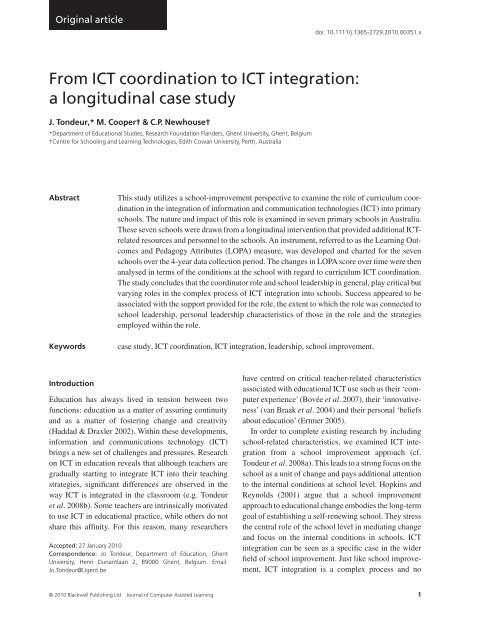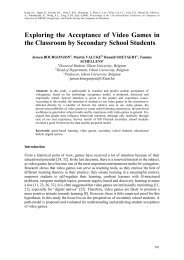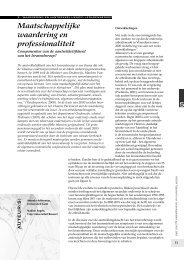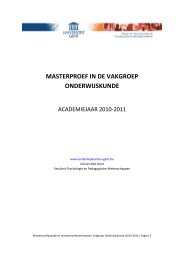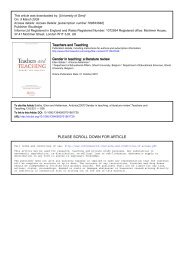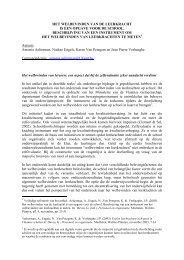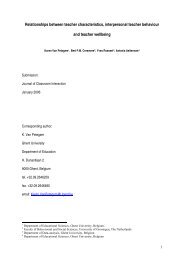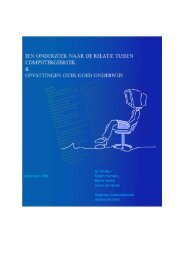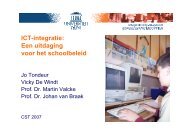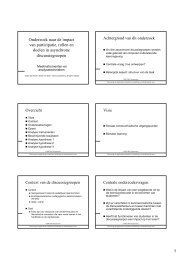From ICT coordination to ICT integration: a longitudinal case ...
From ICT coordination to ICT integration: a longitudinal case ...
From ICT coordination to ICT integration: a longitudinal case ...
Create successful ePaper yourself
Turn your PDF publications into a flip-book with our unique Google optimized e-Paper software.
Original article<br />
doi: 10.1111/j.1365-2729.2010.00351.x<br />
<strong>From</strong> <strong>ICT</strong> <strong>coordination</strong> <strong>to</strong> <strong>ICT</strong> <strong>integration</strong>:<br />
a <strong>longitudinal</strong> <strong>case</strong> studyjcal_351 1..11<br />
J. Tondeur,* M. Cooper† & C.P. Newhouse†<br />
*Department of Educational Studies, Research Foundation Flanders, Ghent University, Ghent, Belgium<br />
†Centre for Schooling and Learning Technologies, Edith Cowan University, Perth, Australia<br />
Abstract<br />
Keywords<br />
This study utilizes a school-improvement perspective <strong>to</strong> examine the role of curriculum <strong>coordination</strong><br />
in the <strong>integration</strong> of information and communication technologies (<strong>ICT</strong>) in<strong>to</strong> primary<br />
schools. The nature and impact of this role is examined in seven primary schools in Australia.<br />
These seven schools were drawn from a <strong>longitudinal</strong> intervention that provided additional <strong>ICT</strong>related<br />
resources and personnel <strong>to</strong> the schools. An instrument, referred <strong>to</strong> as the Learning Outcomes<br />
and Pedagogy Attributes (LOPA) measure, was developed and charted for the seven<br />
schools over the 4-year data collection period. The changes in LOPA score over time were then<br />
analysed in terms of the conditions at the school with regard <strong>to</strong> curriculum <strong>ICT</strong> <strong>coordination</strong>.<br />
The study concludes that the coordina<strong>to</strong>r role and school leadership in general, play critical but<br />
varying roles in the complex process of <strong>ICT</strong> <strong>integration</strong> in<strong>to</strong> schools. Success appeared <strong>to</strong> be<br />
associated with the support provided for the role, the extent <strong>to</strong> which the role was connected <strong>to</strong><br />
school leadership, personal leadership characteristics of those in the role and the strategies<br />
employed within the role.<br />
<strong>case</strong> study, <strong>ICT</strong> <strong>coordination</strong>, <strong>ICT</strong> <strong>integration</strong>, leadership, school improvement.<br />
Introduction<br />
Education has always lived in tension between two<br />
functions: education as a matter of assuring continuity<br />
and as a matter of fostering change and creativity<br />
(Haddad & Draxler 2002). Within these developments,<br />
information and communications technology (<strong>ICT</strong>)<br />
brings a new set of challenges and pressures. Research<br />
on <strong>ICT</strong> in education reveals that although teachers are<br />
gradually starting <strong>to</strong> integrate <strong>ICT</strong> in<strong>to</strong> their teaching<br />
strategies, significant differences are observed in the<br />
way <strong>ICT</strong> is integrated in the classroom (e.g. Tondeur<br />
et al. 2008b). Some teachers are intrinsically motivated<br />
<strong>to</strong> use <strong>ICT</strong> in educational practice, while others do not<br />
share this affinity. For this reason, many researchers<br />
Accepted: 27 January 2010<br />
Correspondence: Jo Tondeur, Department of Education, Ghent<br />
University, Henri Dunantlaan 2, B9000 Ghent, Belgium. Email:<br />
Jo.Tondeur@Ugent.be<br />
have centred on critical teacher-related characteristics<br />
associated with educational <strong>ICT</strong> use such as their ‘computer<br />
experience’(Bovée et al. 2007), their ‘innovativeness’<br />
(van Braak et al. 2004) and their personal ‘beliefs<br />
about education’ (Ertmer 2005).<br />
In order <strong>to</strong> complete existing research by including<br />
school-related characteristics, we examined <strong>ICT</strong> <strong>integration</strong><br />
from a school improvement approach (cf.<br />
Tondeur et al. 2008a). This leads <strong>to</strong> a strong focus on the<br />
school as a unit of change and pays additional attention<br />
<strong>to</strong> the internal conditions at school level. Hopkins and<br />
Reynolds (2001) argue that a school improvement<br />
approach <strong>to</strong> educational change embodies the long-term<br />
goal of establishing a self-renewing school. They stress<br />
the central role of the school level in mediating change<br />
and focus on the internal conditions in schools. <strong>ICT</strong><br />
<strong>integration</strong> can be seen as a specific <strong>case</strong> in the wider<br />
field of school improvement. Just like school improvement,<br />
<strong>ICT</strong> <strong>integration</strong> is a complex process and no<br />
© 2010 Blackwell Publishing Ltd Journal of Computer Assisted Learning 1
2 J. Tondeur et al.<br />
simplified ‘cookbook approach’ can promise success.<br />
Therefore, teachers need considerable support with<br />
regard <strong>to</strong> <strong>ICT</strong> <strong>integration</strong> (Lai & Pratt 2004). Based on<br />
these studies, it appears that teachers reporting a high<br />
degree of school-related <strong>ICT</strong> support incorporate <strong>ICT</strong> in<br />
their practice more often.<br />
The support required by teachers varies in its type and<br />
extent but ultimately requires <strong>coordination</strong>, management<br />
and leadership. Moyle (2006) highlights the critical<br />
role of leadership and particularly in providing<br />
curriculum leadership and support. More often, this<br />
involves a curriculum/pedagogical <strong>ICT</strong> <strong>coordination</strong><br />
role that focuses on supporting teachers <strong>to</strong> facilitate <strong>ICT</strong><br />
<strong>integration</strong>. In this respect, Lawson and Comber (1999)<br />
stress the need for ongoing support by an <strong>ICT</strong> coordina<strong>to</strong>r.<br />
They argue that <strong>ICT</strong> coordina<strong>to</strong>rs are in the best<br />
position <strong>to</strong> provide information about the <strong>ICT</strong> infrastructure,<br />
software, the development of an <strong>ICT</strong> school<br />
policy and <strong>ICT</strong>-related support.<br />
The main aim of this paper is <strong>to</strong> describe the characteristics<br />
of support for <strong>ICT</strong> <strong>integration</strong> in education and<br />
the critical role of the <strong>ICT</strong> coordina<strong>to</strong>r. More specifically,<br />
it examines the role of the <strong>ICT</strong> coordina<strong>to</strong>r with<br />
respect <strong>to</strong> the key fac<strong>to</strong>rs for educational change<br />
emerging from the school improvement approach, such<br />
as the provision of long-term goals and systematic<br />
strategies (Hopkins & Reynolds 2001), and professional<br />
development (S<strong>to</strong>ll 1999). The second aim of the<br />
paper explores the extent <strong>to</strong> which the use of <strong>ICT</strong> in the<br />
classroom practice can be associated with the support<br />
of the <strong>ICT</strong> coordina<strong>to</strong>r and the nature of the role. The<br />
paper is based on a study using data collected for a<br />
large evaluation project in Australia that for purposes<br />
of anonymity will be referred <strong>to</strong> as the Project. The<br />
Project was an intervention in schools that provided<br />
additional <strong>ICT</strong>-related resources (hardware, software,<br />
networking and personnel). The study for this paper<br />
involved <strong>case</strong> studies for seven primary schools within<br />
the Project. The data used was gained by interviewing<br />
the school leader, the <strong>ICT</strong> coordina<strong>to</strong>r, and a sample of<br />
teachers. In addition, a survey was conducted among<br />
all teachers of the schools, the principal, and the <strong>ICT</strong><br />
coordina<strong>to</strong>r, and relevant school documents were<br />
studied. The data for the seven schools were collected<br />
in four waves (between 2005 and 2008). This type of<br />
evaluation, based on a quasi-ethnographical model of a<br />
<strong>longitudinal</strong> <strong>case</strong> study, was chosen because of the<br />
need <strong>to</strong> collect rich data from a specific group of<br />
schools (see rationale provided by Newhouse &<br />
Clarkson 2008).<br />
Before presenting results, we first describe the literature<br />
with respect <strong>to</strong> school improvement and how it can<br />
be related <strong>to</strong> <strong>ICT</strong> <strong>integration</strong> in general and <strong>ICT</strong> <strong>coordination</strong><br />
in particular. In the next section, the development<br />
approach of the study is described. The paper concludes<br />
with a discussion of the results and the implications for<br />
future research.<br />
Background<br />
Supporting <strong>ICT</strong> <strong>integration</strong> from a school<br />
improvement point of view<br />
The literature about school improvement stresses the<br />
importance of school-related support in developing<br />
a commitment <strong>to</strong> educational change (S<strong>to</strong>ll 1999;<br />
Hopkins & Reynolds 2001). It is generally acknowledged<br />
that educational change benefits from a supportive<br />
environment (Fullan 2001). Studies focusing on the<br />
relationship between school-related support and <strong>ICT</strong><br />
<strong>integration</strong> in the classroom are often limited <strong>to</strong> a focus<br />
on access <strong>to</strong> computers and software (cf. Bradley &<br />
Russell 1997). However, effectively integrating <strong>ICT</strong><br />
in<strong>to</strong> learning systems is much more complicated than<br />
providing computers and securing a connection <strong>to</strong> the<br />
Internet. Computers are merely <strong>to</strong>ols; no technology<br />
can fix an underdeveloped educational philosophy or<br />
compensate for inadequate practices (Ertmer 2005).<br />
Critical choices have <strong>to</strong> be made in terms of the relationship<br />
between <strong>ICT</strong> use and educational objectives. In this<br />
respect, the process of supporting <strong>ICT</strong> <strong>integration</strong> is<br />
a dynamic one involving many interacting fac<strong>to</strong>rs<br />
over time.<br />
Therefore, researchers argue for a more holistic<br />
approach <strong>to</strong> study the process of <strong>ICT</strong> <strong>integration</strong> that<br />
considers a range of fac<strong>to</strong>rs (e.g. Kennewell et al.<br />
2000). In these studies, additional fac<strong>to</strong>rs are incorporated,<br />
such as the development of an explicit <strong>ICT</strong> school<br />
policy plan that stresses a shared vision about the role of<br />
<strong>ICT</strong> in education (Tondeur et al. 2008a). It appears that<br />
a strategic <strong>ICT</strong> plan that sets clear goals and defines the<br />
means <strong>to</strong> realize these goals is a crucial step <strong>to</strong>wards<br />
actual <strong>ICT</strong> <strong>integration</strong> (Bryderup & Kowalski 2002;<br />
Vanderlinde et al. 2008). Analysis of school improvement<br />
research also reveals the importance of clear goals<br />
and systematic strategies <strong>to</strong> direct educational change<br />
© 2010 Blackwell Publishing Ltd
<strong>ICT</strong> <strong>coordination</strong> in primary education 3<br />
(e.g. S<strong>to</strong>ll 1999). A sufficient level of school au<strong>to</strong>nomy,<br />
the development of school policies and a collaborative<br />
team seem <strong>to</strong> be positively related <strong>to</strong> school<br />
improvement.<br />
Other key fac<strong>to</strong>rs from the school improvement<br />
approach that can be connected <strong>to</strong> support <strong>ICT</strong> <strong>integration</strong><br />
in the classroom are: strong leadership <strong>to</strong> guide<br />
change efforts (e.g. Gray 1997), professional development<br />
and support for the implementation of reforms<br />
and evaluation systems for moni<strong>to</strong>ring change processes<br />
(e.g. S<strong>to</strong>ll 1999) (for an overview see Tondeur<br />
et al. 2008a). A clear example is the importance of<br />
leadership in managing <strong>ICT</strong> <strong>integration</strong>. Several<br />
studies (e.g. Dawson & Rakes 2003) support the claim<br />
that leadership in promoting change is a key fac<strong>to</strong>r<br />
when it comes <strong>to</strong> merging <strong>ICT</strong> and instruction. School<br />
leaders (principals, <strong>ICT</strong> coordina<strong>to</strong>rs) are in a position<br />
<strong>to</strong> create the conditions <strong>to</strong> develop a shared <strong>ICT</strong> policy.<br />
The leadership dimension is expected <strong>to</strong> have a specific<br />
impact with respect <strong>to</strong> <strong>ICT</strong> <strong>coordination</strong> via its influence<br />
on teacher participation in decision-making,<br />
feelings of uncertainty by teachers and professional<br />
development opportunities (cf. van den Berg et al.<br />
1999). When teachers feel that the school leader stands<br />
behind them, is concerned about their feelings and supports<br />
them when problems arise, they are more likely <strong>to</strong><br />
be stimulated <strong>to</strong> adopt an innovation (Hargreaves<br />
1994).<br />
In addition, as mentioned above, the degree of <strong>ICT</strong><br />
training (Galanouli et al. 2004), the amount of <strong>ICT</strong>related<br />
support (Lai & Pratt 2004) and adequate evaluation<br />
<strong>to</strong> moni<strong>to</strong>r the <strong>integration</strong> of <strong>ICT</strong> (Kennewell et al.<br />
2000) can be connected <strong>to</strong> the other dimensions emerging<br />
from the school improvement theory. Baylor and<br />
Ritchie (2002) argue that <strong>ICT</strong> training has an important<br />
influence on how well <strong>ICT</strong> is embraced in the classroom.<br />
According <strong>to</strong> Cohen and Hill (2001), the most<br />
effective teacher training experiences are school subject<br />
specific practices, immediately relevant for classroom<br />
instruction and connected <strong>to</strong> school policy. While systematic<br />
<strong>ICT</strong> training is clearly useful, Cohen and Hill<br />
(2001) argue that many teachers seek continuous<br />
support, and, therefore, mechanisms need <strong>to</strong> be put in<br />
place <strong>to</strong> ensure that they have adequate access <strong>to</strong> such<br />
support. In this respect, Lawson and Comber (1999)<br />
stress the provision of ongoing support usually facilitated<br />
by the <strong>ICT</strong> coordina<strong>to</strong>r. This brings us <strong>to</strong> the next<br />
section.<br />
Empirical studies on <strong>ICT</strong> <strong>coordination</strong> in education<br />
Clearly, the process of <strong>ICT</strong> <strong>integration</strong> is a dynamic one<br />
involving interacting fac<strong>to</strong>rs and ac<strong>to</strong>rs over time.<br />
Moreover, no single approach exists <strong>to</strong> address the challenges<br />
related <strong>to</strong> the varying perspectives on <strong>ICT</strong> use<br />
(Ertmer 2005). Therefore, considerable support and<br />
<strong>coordination</strong> is needed <strong>to</strong> integrate <strong>ICT</strong> in teaching and<br />
learning processes. It seems that teachers reporting a<br />
high degree of <strong>ICT</strong>-related support incorporate <strong>ICT</strong> in<br />
their practice more often (Galanouli et al. 2004; Lai &<br />
Pratt 2004). Furthermore, research findings confirm that<br />
most of this support is supplied by school-based <strong>ICT</strong><br />
coordina<strong>to</strong>rs (Tondeur et al. 2008a). Coordina<strong>to</strong>rs, in<br />
practice, however, often appear <strong>to</strong> primarily provide<br />
schools with technical expertise, while their impact on<br />
educational or policy-related issues seems limited (Lai<br />
& Pratt 2004). Somekh (1996) noted that the need for<br />
technical support tends <strong>to</strong> take precedence over curriculum<br />
support.<br />
According <strong>to</strong> Lai and Pratt (2004), the main responsibility<br />
of the <strong>ICT</strong> coordina<strong>to</strong>r should be <strong>to</strong> guide<br />
<strong>ICT</strong> <strong>integration</strong> in teaching and learning (curriculum<br />
support). In the study of Tondeur et al. (2008a), principals<br />
indicated a lack of time as an important obstacle for<br />
providing curriculum-related support. It would therefore<br />
be recommended <strong>to</strong> distinguish between ‘technical<br />
<strong>ICT</strong> coordina<strong>to</strong>rs’ providing schools and teachers with<br />
technical support, and ‘curriculum <strong>ICT</strong> (C<strong>ICT</strong>) coordina<strong>to</strong>rs’<br />
focusing primarily on pedagogical support for<br />
integrating <strong>ICT</strong> in<strong>to</strong> the curriculum. Interestingly, many<br />
principals in the study of Tondeur et al. (2008a)<br />
reported that it would be advisable <strong>to</strong> appoint a teacher<br />
as a C<strong>ICT</strong> coordina<strong>to</strong>r in order <strong>to</strong> maintain the innovation.<br />
At this time, it has <strong>to</strong> be stated that local school<br />
policies, such as effective provision of support by the<br />
C<strong>ICT</strong> coordina<strong>to</strong>r, are often underutilized, and it is clear<br />
that <strong>ICT</strong> <strong>integration</strong> is not yet achieved in a systemic or<br />
systematic way in most of the schools (Janssen Reinen<br />
1996). According <strong>to</strong> this study, very few schools can be<br />
labelled as ‘learning organizations’ with a shared commitment<br />
<strong>to</strong> <strong>ICT</strong> <strong>integration</strong>.<br />
The main objective of the Project, from which data<br />
for this paper were drawn, was <strong>to</strong> enhance the capacity<br />
of schools <strong>to</strong> lead change associated with effective<br />
application of <strong>ICT</strong> in<strong>to</strong> the curriculum. A critical component<br />
in this respect was the appointment at each<br />
school of a school-based C<strong>ICT</strong> coordina<strong>to</strong>r. This<br />
© 2010 Blackwell Publishing Ltd
4 J. Tondeur et al.<br />
position was appointed by the principal and was funded<br />
through the Project <strong>to</strong> allow time release based on<br />
school size. Funds were also available <strong>to</strong> allow access<br />
<strong>to</strong> centrally provided professional development and<br />
support for the position. The role of the C<strong>ICT</strong> coordina<strong>to</strong>r<br />
was <strong>to</strong> provide school-based leadership and support<br />
<strong>to</strong> staff as they planned and delivered learning experiences<br />
involving <strong>ICT</strong>; very much in line with that outlined<br />
by Lai and Pratt (2004). The Project also provided<br />
improved <strong>ICT</strong> infrastructure (networking, hardware and<br />
software) and some coordinated professional learning,<br />
and central curriculum and technical support for Principals,<br />
C<strong>ICT</strong> coordina<strong>to</strong>rs and teachers.<br />
Purpose of the study<br />
The literature suggests that the success of <strong>ICT</strong> <strong>integration</strong><br />
depends partly on the support and <strong>coordination</strong> provided<br />
at the school level. In this respect, a first purpose<br />
of the present study is <strong>to</strong> examine the role of the C<strong>ICT</strong><br />
coordina<strong>to</strong>r with respect <strong>to</strong> the key fac<strong>to</strong>rs for educational<br />
change emerging from the school improvement<br />
approach as discussed above: ‘clear goals and systematic<br />
strategies <strong>to</strong> direct educational change’, ‘strong<br />
leadership <strong>to</strong> guide change efforts’, ‘school internal<br />
support <strong>to</strong> ensure <strong>ICT</strong> <strong>integration</strong>’ and ‘evaluation <strong>to</strong><br />
moni<strong>to</strong>r the <strong>integration</strong> of <strong>ICT</strong> and guide <strong>ICT</strong> planning<br />
<strong>to</strong> moni<strong>to</strong>r the <strong>integration</strong> of <strong>ICT</strong>’. The second aim of<br />
the study explores the extent <strong>to</strong> which the use of <strong>ICT</strong> in<br />
the classroom practice can be associated with the<br />
support of this coordina<strong>to</strong>r role.<br />
Research method<br />
Sample<br />
This paper discusses the impact that the C<strong>ICT</strong> coordina<strong>to</strong>r<br />
role had on <strong>ICT</strong> <strong>integration</strong> in a subset of the schools<br />
involved with the Project. To determine this subset, a<br />
selection process was devised <strong>to</strong> provide the most useful<br />
data set from which <strong>to</strong> draw conclusions. This was<br />
based on the following conditions: (1) the school had<br />
participated throughout the four data collection periods<br />
of the Project evaluation; (2) the school teaching staff<br />
consisted of at least six teachers; and (3) the response<br />
rate for the teacher survey was at least 50% for each of<br />
the four data collection periods. As a result of this filtering<br />
process, seven schools remained and these form the<br />
Table 1. Data collection summary.<br />
Data collection<br />
period<br />
Dates Number of<br />
teachers<br />
surveyed<br />
sample upon which this study is based. Table 1<br />
describes this sample over the four data collection<br />
periods.<br />
The seven schools were public (government) primary<br />
schools with staff numbers ranging from 8 <strong>to</strong> 25 and<br />
student numbers from 150 <strong>to</strong> 388 over the course of the<br />
project. All of the schools served low <strong>to</strong> middle socioeconomic<br />
communities and, hence, they were considered<br />
<strong>to</strong> have similar characteristics in terms of financial<br />
resources, infrastructure and staffing. This is important<br />
<strong>to</strong> take in<strong>to</strong> consideration as it reduces the impact of<br />
these variables on the discussion that follows.<br />
Procedure and instruments<br />
Gender<br />
Baseline 2005 86 13 68 11.3<br />
1st comparison 2006 87 14 69 11.8<br />
2nd comparison 2007 74 10 58 12.3<br />
3rd comparison 2008 84 13 67 13.3<br />
Mean years<br />
teaching<br />
experience<br />
To gain concrete insight in<strong>to</strong> the relationship between<br />
<strong>ICT</strong> <strong>coordination</strong> and <strong>ICT</strong> <strong>integration</strong>, the data were<br />
analysed for the seven <strong>case</strong> studies. The study made use<br />
of qualitative and quantitative methods. The data were<br />
collected on school site visits where a researcher spent 1<br />
or 2 days at each school. The data of this cohort of seven<br />
schools were collected in four waves (2005–2008) as<br />
indicated in Table 1.<br />
For each school, the data collection included:<br />
• Interviews with principals, C<strong>ICT</strong> coordina<strong>to</strong>rs and<br />
selected teachers identified by C<strong>ICT</strong> coordina<strong>to</strong>rs as<br />
good <strong>ICT</strong> practitioners;<br />
• Observation of <strong>ICT</strong> facilities and infrastructure;<br />
• Questionnaires administered <strong>to</strong> all teachers, the principal,<br />
and the curriculum <strong>ICT</strong> coordina<strong>to</strong>r; and<br />
• A review of school documents including school<br />
planning/policy documents and teachers planning<br />
documents.<br />
The teacher questionnaire consisted of 16 questions<br />
with multiple parts, some requiring open response and<br />
the others closed response. These questions were<br />
M<br />
F<br />
© 2010 Blackwell Publishing Ltd
<strong>ICT</strong> <strong>coordination</strong> in primary education 5<br />
designed <strong>to</strong> collect data on (1) the frequency of <strong>ICT</strong> use;<br />
(2) the frequency of various teaching strategies (e.g.<br />
work on computer labora<strong>to</strong>ry, work in groups); (3) the<br />
purposes for <strong>ICT</strong> use in the classroom (e.g. illustrate a<br />
concept, analyse information); the perceived outcomes<br />
of classroom <strong>ICT</strong> use (e.g. better curriculum understanding,<br />
engagement); (4) the specific activities the<br />
teacher had been carrying out in the classroom (openended<br />
responses); (5) the teacher’s pedagogical style<br />
(e.g. directs student activities, gives students freedom of<br />
choice); and (6) the teacher’s <strong>ICT</strong> skills across commonly<br />
used applications.<br />
The teacher interviews were structured around 15<br />
questions concerning the class environment and general<br />
pedagogy, and 25 questions concerning the use of <strong>ICT</strong><br />
by students and the teacher, and teacher perception,<br />
knowledge and skills in using <strong>ICT</strong>. The aim was <strong>to</strong><br />
collect similar, but more detailed data <strong>to</strong> that provided<br />
by the questionnaire, in order <strong>to</strong> identify the ‘leading<br />
edge’ for the school in terms of <strong>ICT</strong> use with students.<br />
Coordina<strong>to</strong>r and principal interviews were semistructured<br />
and aimed <strong>to</strong> collect data pertaining <strong>to</strong> <strong>ICT</strong><br />
policy and planning in the school, and perceptions of the<br />
coordina<strong>to</strong>r position and impact of the project on teachers<br />
and students. Observations and school documents<br />
were used <strong>to</strong> support conclusions drawn from the questionnaires<br />
and interviews. These data were summarized<br />
in database files that were all connected <strong>to</strong> a School<br />
Analysis relational database file. The data in these databases<br />
were then further analysed and added <strong>to</strong>, using a<br />
number of rubrics <strong>to</strong> guide judgements. For further<br />
details on the methodology and instruments refer <strong>to</strong><br />
Newhouse and Clarkson (2008).<br />
The measure that is of particular interest <strong>to</strong> this paper<br />
was formed from items in the teacher questionnaires<br />
related <strong>to</strong> <strong>ICT</strong> use <strong>to</strong> enhance pedagogy. This is referred<br />
<strong>to</strong> as the Learning Outcomes and Pedagogy Attributes<br />
(LOPA) measure and was constructed after a review of<br />
international research in<strong>to</strong> the impact of <strong>ICT</strong> on learning<br />
outcomes and pedagogy. This uses judgements on 11<br />
attributes of a learning environment as a measure of<br />
the quality of learning environments and the use of <strong>ICT</strong><br />
<strong>to</strong> improve this quality. These learning environment<br />
attributes were investigation of reality, knowledge<br />
building, active learning, authentic assessment, engagement,<br />
student productivity, higher level thinking, learning<br />
independence, collaboration and cooperation,<br />
learning styles, and physical disabilities. Data from the<br />
surveys of teachers were used <strong>to</strong> firstly calculate a<br />
Teacher LOPA score for each teacher with a notional<br />
maximum score of 11. A School LOPA measure was<br />
determined for each school by averaging the LOPA<br />
scores of the teachers for a school (refer <strong>to</strong> Newhouse &<br />
Clarkson 2008 for further information on the LOPA<br />
measure). The judgements from which the LOPA scores<br />
were calculated were made independently by two<br />
researchers using the databases and rubrics. This<br />
resulted in high inter-rater reliabilities for the LOPA<br />
measure over the course of the Project (correlation coefficients<br />
between 0.8 and 0.9, significant at P < 0.01).<br />
The LOPA scores for the seven selected schools were<br />
calculated for each of the four data collection periods.<br />
Analysis of variance (anova) with post hoc testing<br />
(Bonferroni) was carried out <strong>to</strong> determine statistically<br />
significant differences in LOPA score over the course of<br />
the project. Finally, the School Analysis database was<br />
interrogated with regard <strong>to</strong> these seven selected schools<br />
<strong>to</strong> locate qualitative data relevant <strong>to</strong> <strong>ICT</strong> <strong>coordination</strong><br />
and school leadership. These results were used <strong>to</strong> gain a<br />
deeper qualitative understanding of the LOPA trends in<br />
the schools.<br />
Results<br />
In this section, we first present the results with respect <strong>to</strong><br />
the changes in <strong>ICT</strong> <strong>integration</strong> along the four distinct<br />
data collections. Subsequently, we focus on the impact<br />
of the C<strong>ICT</strong> coordina<strong>to</strong>r in relation <strong>to</strong> the key fac<strong>to</strong>rs<br />
emerging from the school improvement approach and<br />
how this can be linked <strong>to</strong> changes in <strong>ICT</strong> <strong>integration</strong> in<br />
learning and teaching practices.<br />
Observed changes in <strong>ICT</strong> <strong>integration</strong><br />
The first analysis examined whether changes over time<br />
can be observed with respect <strong>to</strong> <strong>ICT</strong> <strong>integration</strong> in the<br />
seven schools. The School LOPA scores for each of the<br />
seven schools were plotted, resulting in the graph shown<br />
in Fig 1. This allowed for comparisons over time and for<br />
general trends <strong>to</strong> be identified. Examining the graph, it<br />
is important <strong>to</strong> note that the LOPA scores for 2005 represent<br />
a true baseline. That is, these data were collected<br />
prior <strong>to</strong> the formal beginning of the Project. Additionally,<br />
the final data collection in 2008 was collected after<br />
the conclusion of the Project. Figure 1 therefore represents<br />
the trends in the school LOPA scores over the<br />
© 2010 Blackwell Publishing Ltd
6 J. Tondeur et al.<br />
Fig 1 Changes in Learning Outcomes<br />
and Pedagogy Attributes score over time.<br />
entire course of the Project intervention that included<br />
support of a C<strong>ICT</strong> coordina<strong>to</strong>r role.<br />
Having obtained the chart in Fig 1, we carried out an<br />
anova <strong>to</strong> test changes in the LOPA scores of the seven<br />
schools (S1, . . . , S7) over time. The four different data<br />
collections were entered as independent variables <strong>to</strong><br />
compare the LOPAscores. The multivariate test shows a<br />
significant effect (F(3, 24) = 6.39; P = 0.002) for all<br />
schools. The corresponding anovas also reveal significant<br />
effects for S1 (F(3, 37) = 4.66; P = 0.007), S4 (F(3,<br />
59) = 6.20; P = 0.001), S5 (F(3, 43) = 2.90; P = 0.046)<br />
and S6 (F(3, 59) = 3.76; P = 0.015). These results show<br />
that the LOPA scale was a sensitive enough measure <strong>to</strong><br />
highlight statistically significant variations in the<br />
schools over time.<br />
Post hoc analyses (Bonferroni criterion) were conducted<br />
<strong>to</strong> verify whether different outcomes are related<br />
<strong>to</strong> different waves in the data collection. Significant differences<br />
are summarized in Table 2.<br />
Table 2 shows that almost all of the statistically significant<br />
changes in school LOPAscores occurred during<br />
the first year (2005–2006) of the Project and <strong>to</strong> a lesser<br />
extent over the first 2 years (2005–2007). Looking again<br />
at Fig 1, this is confirmed by the steep gradients of the<br />
school graphs over this period, particularly for S1, S4<br />
and S6, which had significant increases in their school<br />
LOPA score in the first year. Two other schools, S2 and<br />
S7, had relatively large changes in LOPA over this first<br />
period as well; however, statistically (probably because<br />
of smaller numbers of respondents in these schools),<br />
these results were not significant. Although the following<br />
discussion will focus on the schools with significant<br />
changes (i.e. S1, S4, and S6), the reader may keep in<br />
Table 2. Overview of significant differences in school Learning<br />
Outcomes and Pedagogy Attributes scores over time (analysis of<br />
variance, post hoc Bonferroni).<br />
School Year Multiple comparisons<br />
Mean<br />
difference<br />
Standard<br />
error<br />
All 2005–2006 1.90 0.46 0.002<br />
S1 2005–2006 3.05 0.91 0.011<br />
S4 2005–2006 2.45 0.60 0.001<br />
S6 2005–2006 1.65 0.51 0.012<br />
All 2005–2007 1.56 0.46 0.015<br />
S4 2005–2007 1.99 0.65 0.019<br />
mind that S2 and S7 had similar characteristics over the<br />
first year of the Project. Later in this section, we will<br />
discuss and attempt <strong>to</strong> explain the two schools (S5 and<br />
S7) that do not follow the general pattern in that their<br />
LOPAscore continues <strong>to</strong> rise after the end of the project.<br />
It is also interesting <strong>to</strong> note that the seven schools<br />
began the Project tightly clustered in terms of LOPA<br />
scores and ended the Project (excepting S7) in a similar<br />
way. There is a marginal increase in all schools’ LOPA<br />
scores from 2005 <strong>to</strong> 2008. We believe this marginal<br />
increase represents the residual effect left after the<br />
Project’s cessation and is probably due mainly <strong>to</strong> the<br />
improvements in hardware and network infrastructure<br />
that remained in the schools.<br />
We will now discuss generally the role of the school<br />
leadership and specifically the role of the C<strong>ICT</strong> in each<br />
of the three time periods 2005–2006, 2006–2007, and<br />
2007–2008. As we are examining this data from a<br />
school improvement perspective the key fac<strong>to</strong>rs we will<br />
P<br />
© 2010 Blackwell Publishing Ltd
<strong>ICT</strong> <strong>coordination</strong> in primary education 7<br />
look at are: (1) school internal support, (2) leadership,<br />
and (3) <strong>ICT</strong> planning.<br />
Characterizing C<strong>ICT</strong> support 2005–2006<br />
A majority of the school principals reported that the role<br />
of the C<strong>ICT</strong> coordina<strong>to</strong>r and associated professional<br />
learning activities was critical in the process of <strong>ICT</strong> <strong>integration</strong><br />
in teaching and learning. The principal from one<br />
of the schools (S4) that made significant progress over<br />
this period made the following comment regarding the<br />
C<strong>ICT</strong> coordina<strong>to</strong>r:<br />
The C<strong>ICT</strong> coordina<strong>to</strong>r creates a vibrant, motivating<br />
learning environment whereby pupils use <strong>ICT</strong> as a <strong>to</strong>ol<br />
for learning. He also provides opportunities for teachers<br />
<strong>to</strong> use <strong>ICT</strong> in a meaningful way <strong>to</strong> improve pupils’<br />
outcomes.<br />
(Principal S4)<br />
The extent and nature of this support varied among the<br />
schools. <strong>From</strong> the comments of a number of C<strong>ICT</strong> coordina<strong>to</strong>rs,<br />
it seems that the support within a school was<br />
more likely <strong>to</strong> be successful where it was driven by the<br />
specific teaching and learning needs of the teachers. In<br />
the schools where there was evidence of a significant<br />
increased meaningful use of <strong>ICT</strong> in 2006 (S1, S4 and S6;<br />
see Table 1), the work of the C<strong>ICT</strong> coordina<strong>to</strong>r seemed<br />
<strong>to</strong> be more focussed on one-<strong>to</strong>-one support, role modeling,<br />
scaffolding, peer collaboration and peer support.<br />
The most powerful support has been that which provides<br />
a strong ‘hands-on’ focus. Participating in the learning<br />
journey with my colleagues and helping them problem<br />
solve issues for themselves. Being an advocate for the<br />
use of technologies in the teaching and learning process<br />
and providing a role model for this <strong>integration</strong>.<br />
(C<strong>ICT</strong> coordina<strong>to</strong>r S1)<br />
Further important success fac<strong>to</strong>rs for C<strong>ICT</strong> coordina<strong>to</strong>rs<br />
were their position in the leadership (status) and<br />
decision-making structures within the school as well as<br />
a range of personal characteristics. In the schools that<br />
made significant progress in the first year of the project,<br />
the C<strong>ICT</strong> coordina<strong>to</strong>rs were enthusiastic, experienced<br />
and respected staff members (S1, S4, S6) that were well<br />
supported by the school principal. In the less successful<br />
schools (S3 and S5), the C<strong>ICT</strong> coordina<strong>to</strong>rs were young<br />
teachers and in one <strong>case</strong>, a new graduate.<br />
The C<strong>ICT</strong> coordina<strong>to</strong>r is a long-time and respected<br />
senior staff member. She is a major catalyst in the school.<br />
Those teachers who work with her improved significantly,<br />
for others, there was little change.<br />
(Principal S1)<br />
The schools in which the C<strong>ICT</strong> <strong>coordination</strong> had the<br />
most positive impact tended <strong>to</strong> be those in which wholeschool<br />
curriculum approaches <strong>to</strong> the <strong>integration</strong> of <strong>ICT</strong><br />
in<strong>to</strong> learning programmes were evident. Nevertheless,<br />
in only one of the schools (S1), this whole-school<br />
approach appeared <strong>to</strong> be integrated in an <strong>ICT</strong> school<br />
plan.<br />
<strong>ICT</strong> <strong>integration</strong> within the curriculum will be sustained<br />
in the school plan. <strong>ICT</strong> is embedded in the school curriculum.<br />
The school aims <strong>to</strong> enhance professional learning<br />
for staff. It has a ‘computers as <strong>to</strong>ols not <strong>to</strong>ys’<br />
philosophy, with a focus on improving/enhancing curriculum<br />
access.<br />
(C<strong>ICT</strong> coordina<strong>to</strong>r S1)<br />
Characterizing C<strong>ICT</strong> support between 2006 and 2007<br />
<strong>From</strong> Fig 1, it is clear that in some schools, the <strong>integration</strong><br />
of <strong>ICT</strong> declined between 2006 and 2007. The most<br />
likely explanation was that during 2007 there was a protracted<br />
and serious industrial dispute involving public<br />
school teachers that included a ban on involvement with<br />
professional learning activities and any additional<br />
duties. This situation when combined with the high<br />
turnover of often inexperienced teachers probably led <strong>to</strong><br />
reduced facilitation of <strong>ICT</strong> use in the schools. Few<br />
schools appeared <strong>to</strong> have a formal set of policies and<br />
practices designed <strong>to</strong> handle staff turnover. To tackle<br />
this problem, two schools included <strong>ICT</strong> use and facilitation<br />
within the performance management framework<br />
for teachers (S1 and S2). Nevertheless, it seems that any<br />
overall skills improvements were <strong>to</strong>o slow <strong>to</strong> effect<br />
critical improvements in the use of <strong>ICT</strong> in classrooms.<br />
Most teachers need support and professional learning <strong>to</strong><br />
develop a greater awareness of the range of applications<br />
of <strong>ICT</strong> and higher level skills in operating <strong>ICT</strong> applications.<br />
In particular, they need exposure <strong>to</strong> a range of<br />
applications of <strong>ICT</strong> <strong>to</strong> connect with their literacy and<br />
numeracy programmes. Most teachers need supported<br />
experience in facilitating the use of <strong>ICT</strong> in the classroom<br />
rather than in the labora<strong>to</strong>ry. Very slow progress though!<br />
(C<strong>ICT</strong> coordina<strong>to</strong>r S6)<br />
It appears from the interviews with the C<strong>ICT</strong> coordina<strong>to</strong>rs<br />
that most teachers in the sample schools either<br />
lacked adequate <strong>ICT</strong> competence, or the understanding<br />
of the potential for <strong>ICT</strong> applications <strong>to</strong> relate <strong>to</strong> their<br />
© 2010 Blackwell Publishing Ltd
8 J. Tondeur et al.<br />
curriculum and the learning outcomes for their students.<br />
Similar <strong>to</strong> the finding for 2005–2006, most principals<br />
judged the role of the C<strong>ICT</strong> coordina<strong>to</strong>r <strong>to</strong> be effective<br />
in this respect.<br />
The removal of the lab as a point of skills development<br />
and weekly use in preference for use within classrooms<br />
meant students had a reduced access and very limited<br />
skills development. C<strong>ICT</strong> coordina<strong>to</strong>r is working on<br />
this – men<strong>to</strong>ring teachers and modeling pedagogy.<br />
(Principal S5)<br />
Compared with 2006–2007, this support was organized<br />
more for one-<strong>to</strong>-one support between a C<strong>ICT</strong><br />
coordina<strong>to</strong>r and teacher, rather than whole school<br />
activities. This is illustrated in school S4.<br />
I meet with every teacher at the beginning of term for a<br />
2 h planning session. This session includes links <strong>to</strong> the<br />
Curriculum Framework (specific <strong>to</strong> Learning Areas &<br />
Learning Outcomes), reper<strong>to</strong>ire of teaching strategies,<br />
negotiated brief parameters, reporting criteria, etc. I put<br />
levels in the ‘Get Work folder’ <strong>to</strong> assist teachers in planning<br />
and reporting. Teachers are now able <strong>to</strong> look at how<br />
they can incorporate <strong>ICT</strong> in the design of activities <strong>to</strong> aid<br />
in the achievement of Learning Outcomes rather than just<br />
teaching student skills.<br />
(C<strong>ICT</strong> coordina<strong>to</strong>r S4)<br />
Next <strong>to</strong> the finding that the level of <strong>ICT</strong> use in classroom<br />
practice had decreased in some of the schools;<br />
there was less evidence of teachers being involved in<br />
decision-making through staff meetings, IT committees<br />
or other school meetings. School S2, the only school<br />
with an increased <strong>ICT</strong> use, was an exception, since the<br />
development of their <strong>ICT</strong> school planning was clearly<br />
described.<br />
The principal is very keen on <strong>ICT</strong> supporting a shift in<br />
pedagogy and is specifically tying this <strong>to</strong> the performance<br />
management of the C<strong>ICT</strong> and teachers. He<br />
expects them all <strong>to</strong> incorporate a specific project using<br />
<strong>ICT</strong> and <strong>to</strong> review student work at end of year. He has<br />
built the C<strong>ICT</strong> role in<strong>to</strong> planning in the school and performance<br />
management of teachers.<br />
(C<strong>ICT</strong> coordina<strong>to</strong>r S2)<br />
Characterizing C<strong>ICT</strong> support between 2007 and 2008<br />
In the final year of this study (2008), the role of the<br />
C<strong>ICT</strong> coordina<strong>to</strong>r largely disappeared in five of the<br />
schools and diminished in the other two (S2 and S7),<br />
which had a negative impact on the progress of <strong>ICT</strong> use<br />
in all of these schools. The Project provided funding <strong>to</strong><br />
fulfil the role of C<strong>ICT</strong> <strong>coordination</strong> for a two-year<br />
period (2006–2007). Whether the role continued<br />
depended on the school principal and the available<br />
funds. The principal in S4 for example decided not <strong>to</strong><br />
continue the role of C<strong>ICT</strong> <strong>coordination</strong>.<br />
The C<strong>ICT</strong> no longer has this role in the school because I<br />
believe this support is no longer necessary due <strong>to</strong> other<br />
strategies in place.<br />
(Principal S4)<br />
In S6, the principal reported that the school had<br />
regressed in the use of <strong>ICT</strong> between 2007 and 2008<br />
because of the lack of C<strong>ICT</strong> <strong>coordination</strong>. This principal<br />
stressed the need for more central support for the C<strong>ICT</strong><br />
position. Some principals also cited the need for technical<br />
support. In schools where an <strong>ICT</strong>-related coordina<strong>to</strong>r<br />
position was allocated, this person was mainly<br />
involved in trying <strong>to</strong> maintain the <strong>ICT</strong> infrastructure.<br />
Last year had three principals and this year lost two of the<br />
most <strong>ICT</strong> skilled teachers, including the C<strong>ICT</strong> coordina<strong>to</strong>r.<br />
New C<strong>ICT</strong> coordina<strong>to</strong>r has taken time <strong>to</strong> upskill and<br />
has had <strong>to</strong> deal with many technical problems.<br />
(Principal S2)<br />
In some schools, the reduction in the role of C<strong>ICT</strong><br />
<strong>coordination</strong> had less of a negative impact but was still<br />
mentioned as a concern in interviews. In one of the<br />
more successful schools (S6) between 2005 and 2007,<br />
where the principal reported <strong>to</strong> have a very effective<br />
C<strong>ICT</strong> coordina<strong>to</strong>r, a new C<strong>ICT</strong> coordina<strong>to</strong>r had<br />
struggled <strong>to</strong> support the process of <strong>ICT</strong> <strong>integration</strong> (see<br />
Fig 1). According <strong>to</strong> the principal, she had been provided<br />
with little time, was a much less experienced<br />
teacher and did not appear <strong>to</strong> be perceived <strong>to</strong> be a<br />
leader by many of the staff who were far more<br />
experienced.<br />
Being a younger teacher in an older school, it is likely<br />
that she is not perceived as a leader by many teachers.<br />
(Principal S2)<br />
A critical fac<strong>to</strong>r in the effective support of <strong>ICT</strong> <strong>integration</strong><br />
seems <strong>to</strong> be the existence of a strategy at the<br />
school level that addresses future development and sustainability,<br />
and includes some means of moni<strong>to</strong>ring<br />
progress. This search for a more strategic approach can<br />
be illustrated in the <strong>case</strong> of school S5.<br />
This has certainly had a marked changed in the way we<br />
operate and address our curriculum needs. Three years<br />
ago, there were minimal influences. Today, we au<strong>to</strong>matically<br />
plan, moni<strong>to</strong>r and evaluate and integrate the use of<br />
© 2010 Blackwell Publishing Ltd
<strong>ICT</strong> <strong>coordination</strong> in primary education 9<br />
<strong>ICT</strong>. It is seen as a <strong>to</strong>ol <strong>to</strong> complement all the other<br />
aspects that drive our curriculum implementation.<br />
(C<strong>ICT</strong> coordina<strong>to</strong>r S5)<br />
Finally, it is interesting <strong>to</strong> examine the two schools,<br />
S5 and S7, which, unlike the other schools, increased<br />
their LOPA scores over 2007–2008. Both had significant<br />
changes in leadership in the previous year (2006–<br />
2007) in that at the schools, the principal, who in both<br />
<strong>case</strong>s was supportive of the project, was absent and a<br />
substitute was acting in the position. It is likely that with<br />
the principal’s return, there was renewed energy being<br />
put back in<strong>to</strong> <strong>ICT</strong> <strong>integration</strong>. In school S7, the C<strong>ICT</strong><br />
coordinating role was continued in<strong>to</strong> the 2007–2008<br />
period despite the fact there was no specific funding as<br />
the Project had formally ceased and this may go part of<br />
the way <strong>to</strong> explaining the school’s high final LOPA<br />
score comparative with the rest of the sample. Additionally,<br />
at school S7 during 2006–2007, there was a fire at<br />
the school that burned down the computer labora<strong>to</strong>ry<br />
and this <strong>to</strong>o may have produced a sense of renewal and<br />
enthusiasm at the school with new <strong>ICT</strong> equipment arriving<br />
in 2007–2008.<br />
Discussion<br />
The main aim of this study was <strong>to</strong> examine the role of<br />
the C<strong>ICT</strong> coordina<strong>to</strong>r with respect <strong>to</strong> <strong>ICT</strong> <strong>integration</strong> in<br />
teaching and learning processes. First, the results confirmed<br />
that the support of <strong>ICT</strong> <strong>integration</strong> was dependent<br />
on the C<strong>ICT</strong> coordina<strong>to</strong>r role. This is in line with<br />
research findings suggesting that <strong>ICT</strong> coordina<strong>to</strong>rs are<br />
in the best position <strong>to</strong> provide ongoing <strong>ICT</strong> support<br />
(Lawson & Comber 1999; Lai & Pratt 2004). <strong>From</strong> the<br />
results, it seems that the role of the C<strong>ICT</strong> coordina<strong>to</strong>r<br />
was successful in the first 2 years when adequately supported<br />
and driven by specific teaching and learning<br />
needs for a school. When this support largely disappeared<br />
in the final years, this had a negative impact on<br />
the progress of <strong>ICT</strong> use in most of the sample schools.<br />
In schools where some encouraging progress was<br />
made in <strong>ICT</strong> <strong>integration</strong>, this was largely due <strong>to</strong> the<br />
C<strong>ICT</strong> coordina<strong>to</strong>r as the driving force with support from<br />
the principal. The results of this study suggest the effectiveness<br />
of the role of the C<strong>ICT</strong> coordina<strong>to</strong>r depended<br />
on its connection with leadership in the school and a<br />
range of personal characteristics and the status of the<br />
person in this role (cf. Baylor & Ritchie 2002). This<br />
corroborates previous studies that have shown that<br />
leadership promoting change is a key fac<strong>to</strong>r when it<br />
comes <strong>to</strong> merging <strong>ICT</strong> and instruction (e.g. Dawson &<br />
Rakes 2003). In this respect, the coordina<strong>to</strong>r needed <strong>to</strong><br />
be viewed as a leader in the school by teachers, either on<br />
the basis of personal attributes, longevity at the school<br />
or position in the school. <strong>From</strong> our results, it is clear that<br />
when the C<strong>ICT</strong> coordina<strong>to</strong>r was a strong leader, well<br />
supported by the principal and visible throughout the<br />
school community, there were sustained positive outcomes.<br />
Typically, these C<strong>ICT</strong> coordina<strong>to</strong>rs had a formal<br />
part in the leadership and decision-making structures of<br />
the school.<br />
Nevertheless, in most of the sample schools, a high<br />
staff turnover of often inexperienced teachers made<br />
actions <strong>to</strong>wards <strong>ICT</strong> <strong>integration</strong> difficult in addition <strong>to</strong><br />
developing teachers’ <strong>ICT</strong> skills and understandings.<br />
The development of a school-based <strong>ICT</strong> plan that<br />
includes the coordina<strong>to</strong>r role can be presented as a<br />
promising approach <strong>to</strong> handle barriers such as a high<br />
staff turnover. In this respect, S<strong>to</strong>ll (1999) highlights the<br />
importance of clear goals and systematic strategies <strong>to</strong><br />
direct educational change, with team development and<br />
professionalism of principals, <strong>ICT</strong> coordina<strong>to</strong>rs and<br />
teachers being necessary conditions. Few schools,<br />
however, appeared <strong>to</strong> have any formal set of policies and<br />
practices designed. The study of Tilbury (2004) confirms<br />
that whole-school approaches that involve staff in<br />
learning for change <strong>to</strong>wards sustainability are rare.<br />
Clearly, it seems that a strategic <strong>ICT</strong> school plan needs<br />
<strong>to</strong> be developed that sets clear goals and defines the<br />
means <strong>to</strong> realize these goals (cf. Bryderup & Kowalski<br />
2002; Tondeur et al. 2009).<br />
As could be derived from the interviews with the<br />
principals, it appears that in many of the schools, the<br />
development of whole-school approaches for sustainable<br />
<strong>ICT</strong> <strong>integration</strong>, they believed, was beyond their<br />
resources. In their study, Özdemir and Kılıç (2007)<br />
stress the need for a systemic and comprehensive<br />
support for <strong>ICT</strong> coordina<strong>to</strong>rs, principals and classroom<br />
teachers in the theory, pedagogy and technological<br />
aspects of <strong>ICT</strong> <strong>integration</strong>. They revealed that the inadequate<br />
knowledge and skills of the <strong>ICT</strong> coordina<strong>to</strong>rs<br />
was one of the fac<strong>to</strong>rs against the successful <strong>integration</strong><br />
of <strong>ICT</strong>. This is in contrast <strong>to</strong> the results of this study,<br />
where the principals indicated that the role of the C<strong>ICT</strong><br />
coordina<strong>to</strong>r was critical in the process of <strong>ICT</strong> <strong>integration</strong><br />
in teaching and learning, irrespective of their personal<br />
<strong>ICT</strong> knowledge and skills. One of the reasons for<br />
© 2010 Blackwell Publishing Ltd
10 J. Tondeur et al.<br />
this could be the professional learning they received<br />
through the Project concerning how <strong>to</strong> support their<br />
teachers, particularly in strategies <strong>to</strong> make use of<br />
classroom-based computers. Throughout the subsequent<br />
waves in this study, the C<strong>ICT</strong> coordina<strong>to</strong>rs all<br />
indicated the importance of the support they received<br />
from the central project team and the professional learning<br />
opportunities provided, particularly when this<br />
involved meeting with other coordina<strong>to</strong>rs. Unfortunately,<br />
the role of C<strong>ICT</strong> <strong>coordination</strong> had largely disappeared<br />
in all but two of the sample schools, and even in<br />
these schools, this role had diminished.<br />
Conclusions<br />
This <strong>longitudinal</strong> <strong>case</strong> study provides a close-up view of<br />
C<strong>ICT</strong> <strong>coordination</strong> in primary education. It can be concluded<br />
that the support of an effective C<strong>ICT</strong> coordina<strong>to</strong>r<br />
in a school was an important fac<strong>to</strong>r in motivating staff<br />
and encouraging a whole school facilitation of <strong>ICT</strong> use<br />
<strong>to</strong> support learning. More specifically, it seems that the<br />
C<strong>ICT</strong> coordina<strong>to</strong>r was more likely <strong>to</strong> be successful<br />
where the support was driven by the specific teaching<br />
needs of the teachers. Examples of strategies resulting<br />
in an increased use of <strong>ICT</strong> were one-<strong>to</strong>-one support, role<br />
modeling, scaffolding, peer collaboration and peer<br />
support. The findings also suggest that successful <strong>ICT</strong><br />
<strong>coordination</strong> is clearly related <strong>to</strong> dimensions emerging<br />
from a school improvement perspective, such as its connection<br />
with leadership. In this respect, the study underpins<br />
the importance of including C<strong>ICT</strong> coordina<strong>to</strong>rs as a<br />
formal part in the leadership and decision-making structures<br />
of the school. Also critical were the C<strong>ICT</strong> coordina<strong>to</strong>r’s<br />
interpersonal and organizational skills, their<br />
understanding of the curriculum, and their own competence<br />
in using <strong>ICT</strong> for learning and instruction. It was<br />
important that their role revolved around curriculum<br />
and was clearly distinguished from that of technical<br />
support. A critical dimension that was missing in most<br />
of the sample schools was the existence of a strategy at<br />
the school level that addressed future development and<br />
sustainability, and included some means of moni<strong>to</strong>ring<br />
progress.<br />
The knowledge base presented in this study is by no<br />
means definitive or exhaustive. Understanding one<br />
element leads <strong>to</strong> the necessity <strong>to</strong> understand the foundation<br />
on which that element rests, which in turn leads <strong>to</strong><br />
the discovery of other significant elements.Although, in<br />
the broadest sense, the process for <strong>ICT</strong> <strong>integration</strong> in<br />
education appears <strong>to</strong> be straightforward, underlying it is<br />
a complex set of interrelated fac<strong>to</strong>rs. An important conclusion<br />
arising from this study is that the school-based<br />
support from a C<strong>ICT</strong> coordina<strong>to</strong>r has the potential <strong>to</strong><br />
become a vehicle <strong>to</strong> promote this complex process of<br />
<strong>ICT</strong> <strong>integration</strong>.<br />
Acknowledgements<br />
The research presented in this paper is based on the work<br />
of a research team organized by the Centre for Schooling<br />
and Learning Technologies at Edith Cowan University.<br />
The team was led by Paul Newhouse and Ron Oliver, and<br />
includes senior researchers Barnard Clarkson, Jan Gray,<br />
Jeremy Pagram, Chris Brook, Martin Cooper and<br />
Bridget Leggett, project manager and researcher Lorraine<br />
Kershaw, and many research assistants. The work<br />
of everyone in this team has contributed <strong>to</strong> the research<br />
outcomes presented in this paper. Finally, it is acknowledged<br />
that this paper includes a snapshot of data collected<br />
during the initial stages of a project and as such<br />
does not reflect the outcomes or the ongoing management<br />
of the project nor outline other impacts of the<br />
project.<br />
References<br />
Baylor A.L. & Ritchie D. (2002) What fac<strong>to</strong>rs facilitate<br />
teacher skill, teacher morale, and perceived student learning<br />
in technology-using classrooms? Computers & Education<br />
39, 395–414.<br />
Bovée C., Voogt J. & Meelissen M. (2007) Computer attitudes<br />
of primary and secondary students in South Africa. Computers<br />
in Human Behavior 23, 1762–1776.<br />
Bradley G. & Russell G. (1997) Computer experience, school<br />
support, and computer anxiety. Educational Psychology:<br />
An International Journal of Experimental Educational Psychology<br />
17, 267–284.<br />
Bryderup I.M. & Kowalski K. (2002) The role of local<br />
authorities in the <strong>integration</strong> of <strong>ICT</strong> in learning. Journal of<br />
Computer Assisted Learning 18, 470–479.<br />
Cohen D. & Hill H. (2001) Learning Policy: When State Education<br />
Reform Works. Yale University Press, New Haven,<br />
CT.<br />
Dawson C. & Rakes G.C. (2003) The influence of principals’<br />
technology training on the <strong>integration</strong> of technology in<strong>to</strong><br />
schools. Journal of Research on Technology in Education<br />
36, 29–49.<br />
© 2010 Blackwell Publishing Ltd
<strong>ICT</strong> <strong>coordination</strong> in primary education 11<br />
Ertmer P.A. (2005) Teacher pedagogical beliefs: the final<br />
frontier in our quest for technology <strong>integration</strong>?<br />
Educational Development Research and Development<br />
53, 25–39.<br />
Fullan M. (2001) The New Meaning of Educational Change,<br />
3rd edition. RoutledgeFalmer, London.<br />
Galanouli D., Murphy C. & Gardner J. (2004) Teachers’ perceptions<br />
of the effectiveness of <strong>ICT</strong>-competence training.<br />
Computers & Education 43, 63–79.<br />
Gray P.J. (1997) Viewing assessment as an innovation: leadership<br />
and the change process. In New Directions for Higher<br />
Education, No. 100 (eds P.J. Gray & T.W. Banta), pp. 5–15.<br />
Jossey-Bass, San Francisco, CA.<br />
Haddad W.D. & Draxler A., eds (2002) Technologies for Education:<br />
Potentials, Parameters and Prospects. AED/<br />
UNESCO, Washing<strong>to</strong>n, DC/Paris.<br />
Hargreaves A. (1994) Changing Teachers, Changing Times.<br />
Cassell, London.<br />
Hopkins D. & Reynolds D. (2001) The past, present and future<br />
of school improvement: <strong>to</strong>wards the Third Age. British<br />
Educational Research Journal 27, 459–476.<br />
Janssen Reinen I. (1996) Teachers and computer use. The<br />
progress of integrating IT in the curriculum. Doc<strong>to</strong>ral Dissertation,<br />
Twente University, Twente.<br />
Kennewell S., Parkinson J. & Tanner H. (2000) Developing<br />
the <strong>ICT</strong> Capable School. RoutledgeFalmer, London.<br />
Lai K.W. & Pratt K. (2004) Information and communication<br />
technology (<strong>ICT</strong>) in secondary schools: the role of the computer<br />
coordina<strong>to</strong>r. British Journal of Educational Technology<br />
35, 461–475.<br />
Lawson T. & Comber C. (1999) Superhighways technology:<br />
personnel fac<strong>to</strong>rs leading <strong>to</strong> successful <strong>integration</strong> of information<br />
and communication technology in schools and colleges.<br />
Journal of Information Technology for Teacher<br />
Education 8, 41–53.<br />
Moyle K. (2006) Leadership and learning with <strong>ICT</strong>. Voices<br />
from the profession: what Australian school leaders say. In<br />
Proceedings of World Conference on Educational Multimedia,<br />
Hypermedia and Telecommunications 2006 (eds E.<br />
Pearson & P. Bohman), pp. 89–96. AACE, Chesapeake,<br />
VA.<br />
Newhouse C.P. & Clarkson B.D. (2008) Using learning environment<br />
attributes <strong>to</strong> evaluate the impact of <strong>ICT</strong> on learning<br />
in schools. Research and Practice in Technology Enhanced<br />
Learning 3, 139–158.<br />
Özdemir S. & Kılıç E. (2007) Integrating information and<br />
communication technologies in the Turkish primary school<br />
system. British Journal of Educational Technology 38,<br />
907–916.<br />
Somekh B. (1996) Value conflicts in the management of innovation:<br />
supporting information technology innovation in<br />
initial teacher training in the United Kingdom. Journal of<br />
Information Technology for Teacher Education 5, 115–137.<br />
S<strong>to</strong>ll L. (1999) Realising our potential: understanding and<br />
developing capacity for lasting improvement. School Effectiveness<br />
and School Improvement 10, 503–532.<br />
Tilbury D. (2004) Rising <strong>to</strong> the challenge: education for sustainability<br />
in Australia. Australian Journal of Environmental<br />
Education 20, 103–114.<br />
Tondeur J., Van Keer H., van Braak J. & Valcke M. (2008a)<br />
<strong>ICT</strong> <strong>integration</strong> in the classroom: challenging the potential<br />
of a school policy. Computers & Education 51, 212–223.<br />
Tondeur J., Valcke M. & van Braak J. (2008b) A multidimensional<br />
approach <strong>to</strong> determinants of computer use in primary<br />
education: teacher and school characteristics. Journal of<br />
Computer Assisted Learning 24, 494–506.<br />
Tondeur J., Devos G., Van Houtte M., van Braak J. & Valcke<br />
M. (2009) Understanding structural and cultural school<br />
characteristics in relation <strong>to</strong> educational change: the <strong>case</strong> of<br />
<strong>ICT</strong> <strong>integration</strong>. Educational Studies 35, 223–225.<br />
van Braak J., Tondeur J. & Valcke M. (2004) Explaining<br />
different types of computer use among primary school<br />
teachers. European Journal of Psychology of Education 19,<br />
407–422.<br />
van den Berg R., Vandenberghe R. & Sleegers P. (1999) Management<br />
of innovations from a cultural-individual perspective.<br />
School Effectiveness and School Improvement 10,<br />
321–351.<br />
Vanderlinde R., van Braak J., De Windt V., Tondeur J.,<br />
Hermans R. & Sinnaeve I. (2008) Technology curriculum<br />
and planning for technology in schools: the Flemish <strong>case</strong>.<br />
TechTrends 52, 23–26.<br />
© 2010 Blackwell Publishing Ltd


